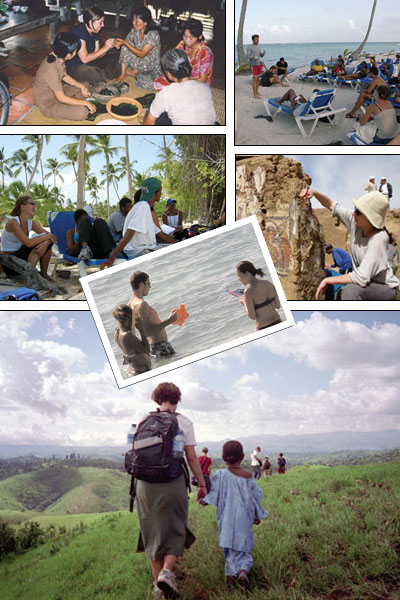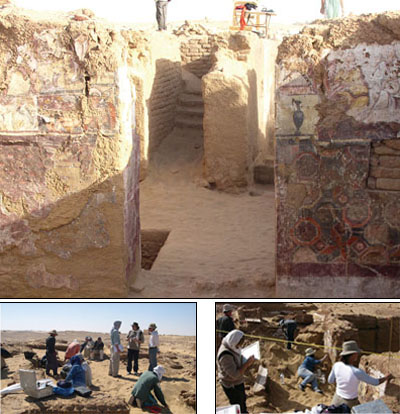|
|
 |
 |
 |
 |
|
FEATURESCampus Without BoundariesMore College students than ever are spending part of their academic careers studying abroad, and are doing so in more varied localesBy Tami Luhby ’92Getting around Ho Chi Minh City with her limited Vietnamese proved no problem for Molly Hartman-O’Connell ’04. But when she arrived in the Mekong Delta to do field work during her study abroad program, she found herself at a loss for words. An anthropology major with a concentration in Asian-American studies, Hartman-O’Connell was unable to communicate with her host family and to participate in their cooking rituals when she arrived in March 2003. But the family proved so friendly and patient that Hartman-O’Connell soon was harvesting rice, feeding the fish and making rice wine with the two daughters. By June, she was helping to cut lettuce leaves and arrange the breads in front of the altar for one family’s ancestral celebration and feast. “In the beginning, I was unable to do anything, but by the end I was totally part of what they were doing,” says the Brooklyn native. As the first College student to study in Vietnam in an approved program, Hartman-O’Connell joins the growing ranks of undergraduates traveling to far-flung reaches of the globe. Students increasingly are venturing to Africa, Latin America, Eastern Europe and the Middle East, among other places, says Associate Dean of Academic Affairs Kathleen McDermott, who heads the College’s Study Abroad program. This trend of going to developing countries has helped fuel the overall growth of the Study Abroad program. The College sends more than 300 undergraduates per year overseas, more than double the number of a decade ago.
Columbia students’ increased interest in studying abroad mirrors a national trend. The number of college students studying abroad soared to 160,920 in 2001–02, up from 71,154 a decade earlier, according to statistics published by the Institute of International Education. The number of students studying in places other than Western Europe also has grown dramatically, with China, Japan, Thailand, South Africa and Brazil registering some of the largest increases. “The issues [students] are looking at are global issues that cross borders, so they need to know more about parts of the world that are not necessarily part of the Western Civilization curriculum,” says Peggy Blumenthal, vice president for educational services at the IIE, which administers the Fulbright and other study abroad programs. “They are realizing that their careers will be global, and they need cross-cultural, language and confidence skills.” To be sure, many Columbia students still choose traditional programs in Western Europe. About two-thirds of participants pick that region, opting to study at places such as Reid Hall, Columbia’s long-standing program in Paris, or the Berlin Consortium for German Studies. England and Spain also are popular. But it’s not simply a European vacation for these students, McDermott says. Gone are the days when studying abroad meant lounging on the beaches of France or clubbing all night in Spain. The number of approved programs shrunk after the faculty Committee on Study Abroad made sure each one immersed students into the culture and instituted rigorous academic requirements. These changes were part of a larger revamping of the program, which occurred about five years ago, in order to encourage more students to take advantage of the opportunity. The faculty became more involved, which helped prompt more undergraduates to apply, says Dean of Academic Affairs Kathryn Yatrakis. And the administration streamlined the application process so students knew to go to McDermott with questions or issues. Years ago, students inquiring about studying abroad were told about the overwhelming bureaucracy involved and the difficulty in transferring credits. Now, they can attend a daylong fair during the fall semester, where they can learn about different overseas opportunities and find out how to take advantage of them. Study abroad veterans are on hand to talk about their experiences and show off their photo albums. Students also can go to the Study Abroad program’s website to get answers to frequently asked questions. Faculty say experiencing foreign countries and cultures first-hand is important. In addition to immersing students in a different culture, it can broaden their views on other countries as well as their own. “Studying abroad can be integral to their majors and help them with their studies,” said Karen Van Dyck, professor of modern Greek literature. “You see not only other cultures from inside, but you see your own culture [differently].”
When Gideon Fink Shapiro ’04 decided to study abroad in the fall of his junior year, he looked for a program that would get him out of the classroom and into the culture. The Cincinnati native chose to go to Cameroon through the School for International Training Study Abroad program, attracted by its theme, “Culture and Development” and its month-long independent study opportunity. There, he studied workers’ struggles and labor unions in a developing country and learned how to do culturally sensitive interviews and archival research. He spent a month each in three cities, each with a “radically different culture.” For example, Dschang was a small university town with only two paved roads, while Yaoundé was a cosmopolitan capital with skyscrapers and more than a million residents. And through his host families and his “brother,” who took him to dance clubs, town markets and soccer games, he participated in everyday life and learned about rituals, such as the importance of greetings. The experience gave him a new view on Africa and made him realize how much more there was to the continent than the stereotypical images of war, famine and the jungle. And it changed his view on his homeland, as well. “It was totally different to build relationships and see how people carry on daily lives in a rich culture and struggle to improve their lives. I was a participant in a foreign culture, as well as an observer and researcher,” says Shapiro, an urban studies major. “It made me look at my own culture differently. I had to appreciate certain things differently because lots of Cameroonian people expressed real envy at my being able to jump on a plane and go to the U.S. I went feeling critical of the U.S. but I had to face the fact that though American politics and culture have faults, they also have characteristics that make them appealing to others. I came to appreciate the dichotomy of American life.” Detailing their trips abroad on film earned Shapiro and Hartman-O’Connell photography honors in the 2003–04 Cross-Cultural Connections Contest, which allows students to tell of their experiences creatively. Shapiro’s picture is from the village of Njili, Cameroon, while Hartman-O’Connell’s is of a Mekong Delta family preparing food. Erica Wolff ’04 won for her essay on her time in Prague. [Editor’s note: Both winning photos accompany this article. To read Wolff’s winning essay, go to www.college.columbia.edu/aboutcc/news/cross_cultural_wolff.php.]
One reason that more undergraduates are flocking to far-off lands is the growth of new ethnic majors and programs at the University, McDermott says. The Institute for Research in African-American Studies was founded in 1993 and Latino and Asian-American programs were created in the mid-1990s after students pushed for the creation of more studies relating to the American experience of people of color. Environmental studies also has risen in prominence on campus in recent years, with the establishment of the department of ecology, evolution and environmental biology (E3B) in 2001. Learning about these subjects in class fuels students’ interest to see and experience these parts of the world first-hand. Thus, more venture to Asia, Africa and South America, or to places such as Brazil and the Dominican Republic to study the tropical forests or marine ecosystems. “As new majors and new areas of endeavor are created, these programs follow,” McDermott noted. The E3B program helped prompt the launch of the Summer Ecosystem Experience for Undergraduates, which took students to the Dominican Republic in 2003. Created by Don Melnick, who holds the Distinguished Professorship in Conservation Biology and is the executive director of the Center for Environmental Research and Conservation, the five-week summer session allows students to study marine and inner tidal ecosystems. (A similar course in Brazil, which studies the tropical forest, is in its fifth year.) While many students take the class to fulfill two semesters of Columbia’s science requirement, program director James Danoff-Burg admits, there are budding scientists in the mix. Several participants have switched their majors to environmental biology or have become more active in environmental groups.
Seth Rosenfeld ’06, a political science major who signed up for the program last summer, considered environmental science as a concentration and took a climate systems class as a freshman. He wanted the chance to do field research and to see what impact development has on biodiversity. Rosenfeld’s classes included studying beach erosion by looking at water levels and coastal plant growth and biodiversity in the country’s interior rain forests. His independent research project was on the effect of tidal patterns on sea urchins. A Bloomfield Hills, Mich., native, Rosenfeld learned that while a resort or a development may be labeled sustainable or eco-friendly, it often doesn’t adhere to the principles of minimal impact on local biodiversity. “It’s a lot easier for us in wealthier countries to talk about protecting the environment,” Rosenfeld said. “It’s a lot harder in developing counties, where the only resources of the developing economy are drawn from the environment.” Faculty can be critical to the expansion of study abroad programs at the College. Classics and history professor Roger Bagnall took three students to Egypt last spring to participate in the excavations at Amheida. He described it as the only program of its kind that includes excavation experience. This opportunity appealed to Julia Abbott ’05, a classics
major from Boulder, Colo. Though she’s spent many years abroad,
she had never been to an Arab country or to Africa. She reveled
in the discussions and visits to sites at Luxor and Kharga Oasis,
where she gazed upon the ruins not as a tourist, but as a scholar
looking at their role in history. College or SEAS undergraduates seeking study abroad information should visit www.studentaffairs.columbia.edu/studyabroad and contact their class dean. Tami Luhby ’92 covers personal finance
for Newsday.
|
|
||||||||||||||||||||||||||||||||||||||||||||||||||||||||||||||||||||||

